BlackBerry Classic review: A love letter to fans and few others

Let's put Apple, Samsung and all their ilk aside for few moments: It really wasn't that long ago that a homegrown Canadian company called BlackBerry (well, RIM at the time) basically ruled the mobile world. The outfit's slow decline has been chronicled, opined upon for years, and yet, some of BlackBerry's most ardent fans still clamor for the days when QWERTY keyboards and teensy trackpads were uber-efficient status symbols instead of the relics they are now.
Enter the BlackBerry Classic. The name says it all, really: It's a paean to BlackBerry's halcyon days, and it's got a look plucked straight out of 2011, to boot. We took one for an extended spin to see how BlackBerry's throwback formula holds up today, and (very long story short) it's mostly the past mashed up with a touch of the modern. The bigger question, as usual, is whether or not it's worth your time. I suspect you already know the answer, but read on for my full impressions.
Hardware

Historically, BlackBerry has been uneven when it came to build quality: For every tank the company put out, there was one that was unsatisfyingly light. Even the venerable Curves and Pearls of yore skewed toward the lighter, plasticky end of the spectrum. Not so here. The Classic is dense and solidly constructed, as if to declare -- loudly -- that it's more of a tool than a toy. One thing the Classic doesn't share with its old-school comrades is the ability to pop off the rear cover for a foolproof restart or a handy battery swap. No, its dimpled back plate is affixed to the chassis, so all you'll be able to do with it is finger the chrome BlackBerry logo and gaze at the 8-megapixel camera and LED flash running across the top of the Classic's backside.
Itching to pop in a SIM or a microSD card? Hope you've got a paper clip handy; you'll need one to access the pair of trays along the phone's left side. On the opposite edge, there's a pair of volume buttons separated by a key dedicated to launching the digital assistant (more on that later). And the front? It's just the sort of blast from the past I expected here. It's even got a notification light to pulse at you whenever an email lands in your inbox to complete the historic look. Rounding out the facade is a 2-megapixel fixed-focus camera lodged above the 3.5-inch square 720p screen.
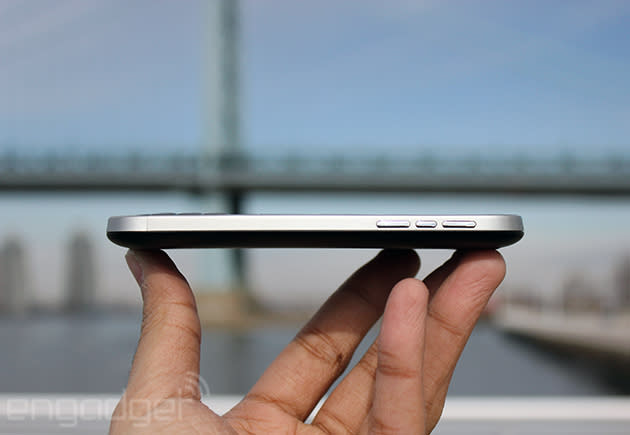
Below all that lies the affectionately named "tool belt," bringing along dedicated Call, End, Menu and Back buttons... and a trackpad. It's been years since I've seen an optical trackpad on a smartphone, let alone used one in lieu of a touchscreen to get stuff done. And you know what? I didn't miss them at all, or so I thought. After a few days, my tune started to change, if only a little. In case it wasn't apparent, the Classic's tiny black nub helps you ably home in on teensy links and subtly nudge the cursor between letters so you can polish off that witty Twitter retort. For such minute operations, the trackpad is just lovely. You can use it for grander gestures too, like scrolling through a story, but in those cases it never feels quite as comfortable swiping a thumb down a glass touchscreen (Gorilla Glass 3, in this case).
If anything, it almost makes more sense as a supplement to a touchscreen than a means of navigation unto itself. The rest of the tool belt is as straightforward as it is functional, with only the Menu button coming off like a relic. BlackBerry has spent more than two years refining the way BB10 works with a touchscreen, adding gestures that feel natural and replace the Menu key almost entirely.
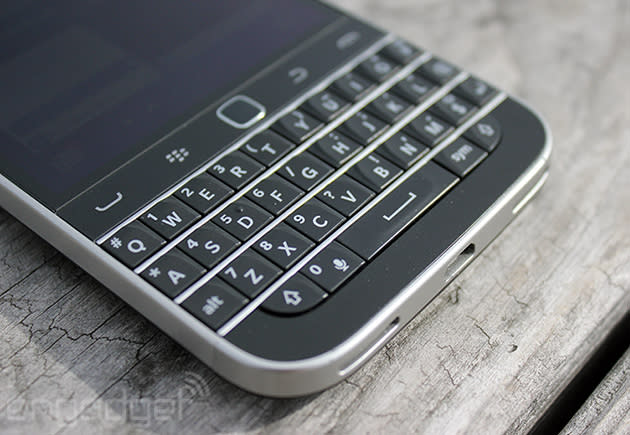
And then there's the keyboard. I've always been fond of retro devices like the BlackBerry Tour 9630, a phone whose tiny QWERTY keys got me through at least one college paper dissecting some long-dead poets and a failed relationship or two. The Classic has a pretty standard four-row affair, with all your letters, numbers and punctuation crammed into the top three rows leaving the space bar and Symbol keys (remember those?) all by themselves. If you've never picked up a BlackBerry before, the size and density of these keys will take some time to get used to; it took three or four days before muscle memory kicked in and I could peck out messages with something approaching the fury I used to have. And after that? I wouldn't quite call it typing nirvana, but there's a comforting amount of travel and a satisfying click to those keys. Welcome home, BlackBerry fans. It would've been nice if the company had transplanted some of that sweet, sweet gesture-tracking tech we saw in the Passport into the Classic, but "newfangled" isn't the name of the game here.
Display and sound
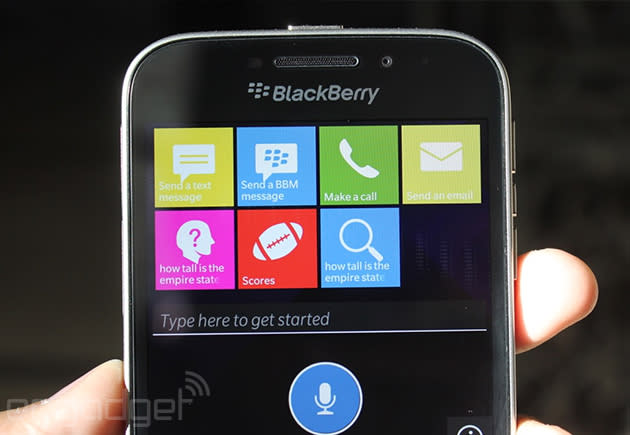
Beyond the obvious Huey Lewis joke, there isn't a lot to be said about the Classic's 3.5-inch square screen; it's bright enough to use in direct sunlight, and colors are plenty vivid, too. BlackBerry was kind enough to let you tweak the screen's white balance right from the settings, something that just about every other smartphone maker out there is loath to do. Is it going to do much good for anyone who isn't seriously finicky? Maybe not, but I couldn't help but dial down the default warmth level a touch anyway. It's certainly not the most pixel-dense screen you'll encounter, which is slightly tragic since the Passport squeezes four times as many active pixels into a screen that's only an inch bigger diagonally. Once again, we've got BlackBerry's business-friendly mantra to thank here; small as the display is, there's still enough space to get you thumbing through emails and tweets without too many complaints.

Speaking of the sort, yes, I've got a few. A square display doesn't sound all that obtuse in theory, but the reality can be rougher than you might think. The lack of vertical screen space means that your thumb will get more of a workout because of the additional scrolling needed to plow through an article. The kicker: Just about every video you watch on your phone will be flanked by some serious letterboxing thanks to the aspect ratio mismatch. You'll usually find way more empty space surrounding a video than there is video itself, but that's fine -- the lackluster speaker lodged on the Classic's bottom helps ensure you won't want to watch for long anyway.
There's a noticeable hollowness -- a lack of depth -- to the sound issuing forth from the driver, which I guess is in keeping with the Classic's predilection for serious business. (Don't be fooled by the other speaker-like grille on the other side of the micro-USB port; that's the microphone.) You'll want to plug in some headphones to get the full experience -- such that it is -- but avoid the ones that come in the box. When I tear into the packaging of a new phone, those pack-ins are usually the first things that get tossed in the junk drawer and these earbuds were destined for the same fate. They're a comfortable pair, even surprisingly so, but they sound pretty lousy. Grab a $10 pair from your local big-box store -- trust me. You'll be a lot happier.
Software

We did a deep dive on BlackBerry 10.3 when we played with the Passport last year, so I won't dwell too much on the nitty-gritty. Suffice to say, the platform has come a long way since those early days. The version loaded on the Classic (10.3.1, to be precise) looks a little flatter and feels more polished than builds we've futzed with in the past. Let's start from the top.
The BlackBerry Hub (a slide-out panel that offers tantalizingly quick access to all of your messages) continues to be the best part of the BB10 experience. No matter where you are, no matter what app you've got running, that unified inbox is just a swipe away. For FOMO-prone types like me, it's a godsend. BB10 also sports what's probably my favorite visual multitasking metaphor since the days of webOS cards, and now you can dismiss each of those apps (up to eight of those active frames are visible at any one time) with a click of the Back button when they're highlighted.
New to this build is the ability to run apps in the background without an active frame, which can be jarring the first few times; I apparently granted Rdio background access and it took me time to figure out how to kill it. Those two features in tandem speak to just how seriously BlackBerry takes its beloved productivity angle, and it doesn't stop there. I won't lie: I bristled at the idea of loading up my full-to-the-brim work computer with yet another mostly pointless smartphone-management app, but BlackBerry Blend is probably the best-executed of the lot. Setup took all of a few moments once I remembered my BlackBerry account details, and marking emails as read and adding calendar entries reflected immediately on the Classic. Good stuff.
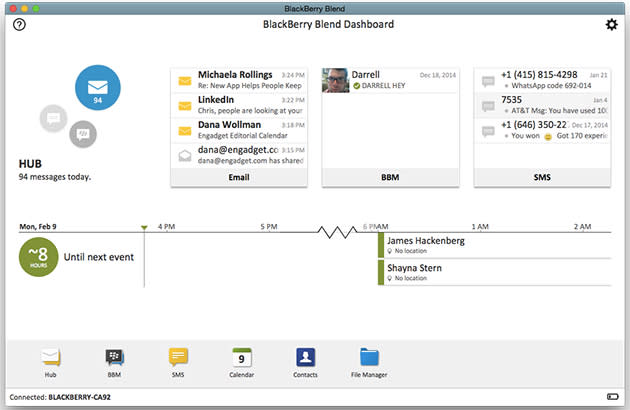
Even some of BB10's me-too features impressed, like BlackBerry's virtual assistant (which also doubles as the Search interface whenever you start typing something while on the home screen). Thing is, invoking it by holding a button on the side of the phone was strangely inconsistent; it'd work just fine about 95 percent of the time, but I've spent more time scratching my head wondering about the other 5 percent than I care to. It's a silly little error, and one that needs fixing. Once you've roused it, though, your phone-bound concierge is plenty smart. I needed to dig up a scheduling email from my boss sent weeks ago, and just couldn't be bothered to do all the swiping and typing required. Instead, I asked my assistant if I had "any messages about news from Terrence," and a moment later, it surfaced exactly what I was looking for.
It didn't take long for me to use the BlackBerry Assistant for other things I could've easily done by hand. Turning off Bluetooth and turning on WiFi? Launching apps? Checking in on Foursquare? All easily handled by talking at a phone. After a while, it became less about the utility of the thing and more about seeing how awkward I could get before it stopped recognizing my words. (I gave up when the assistant correctly rendered and interpreted "What type of Pokémon is Charizard?" with Wolfram Alpha's help.) If the assistant dismissed itself and let me pick up where I left off, I'd like it even more.

And now it's time we acknowledge the hulking mammoth in the room: There's still a noticeable dearth of apps for BlackBerry 10. CEO John Chen knows just how dire the problem is. In an open letter meant to tap into a larger conversation about net neutrality, he basically asked developers of big-name apps to bring their wares to BlackBerry 10 because, well, it's only fair right? Sorry, John. It's a shitty, vicious circle, but that's just not how it works and the end result is an app landscape that still feels barren even after two years.
Let's consider some of the big names, shall we? I don't post much on Facebook and Twitter, but I'm a sucker for sharing photos on Instagram. Those first two social networks are well represented by a pair of native apps, but you'll have to turn to third-party offerings to get your filtered-food-photos fix. Productivity and communications tools like HipChat, Yammer, Convo and Slack don't exist in BlackBerry World either, and that's a shame considering the Classic's business-friendly ethos. Those omissions alone mean this thing wouldn't fly as a work tool here at Engadget, nor in any of my other post-college jobs. When it comes to media, there's Pandora, but no Rdio or Spotify apps. That said, you can find versions of the latter two in Amazon's Android app store. If you're looking for something really specific, you'll have to get your hands on the Android .APK and sideload it onto your Classic. Thankfully, that's gotten easier over the past few months; with a little patience and some elbow grease, you can get a mostly working version of the Google Play Store running on BlackBerry 10 devices.
Camera

Summing up BlackBerry's classic device philosophy is pretty simple: They're great for business and lousy as cameras. Sad to say, but history really does repeat itself; neither the 8-megapixel rear shooter nor the 2-megapixel selfie camera is worth writing home about. Out of the box, the Classic was set to shoot photos with a 1:1 aspect ratio, which is great for Instagram and the square screen, but less so for viewing images on other displays. A quick pop into the Settings will fix that right up; from there you can choose 4:3, 16:9 or a new panorama mode.
BlackBerry's promo materials insist that the Classic's camera is snappy, and you know what? It is -- when it wants to be. With the sun overhead or bright lights nearby, you can hardly tell you've snapped a photo at all -- it's that fast. (There's also something satisfying about using the space bar to snap a shot, but I digress.) Thing is, the camera does an about-face in dim conditions where you need to use the flash. I've spent too much time after pressing the shutter button wondering if it worked -- only to move my hand inadvertently, and then I realize I've just ruined a picture in progress. Even under otherwise decent conditions, letting the camera autofocus can take a while, and even then it has trouble locking on stuff in the foreground. Unless you drag the focus reticle around yourself, expect your fair share of soft photos.
On the upside, images are reasonably detailed and pretty well-saturated. A semiautomatic HDR mode helps fill in the gaps, though; whenever you point the camera at a brightly lit scene, a notification drops down from the top asking if wouldn't rather HDR-ize whatever you're looking at. Honestly, you might as well just use it full-time. Naturally, the Classic shoots 720p or 1080p video in a pinch with mostly pleasing results: Colors aren't oversaturated and the resulting footage is lacking in crispness, but it's enough to capture the kids flinging their first spoonfuls of macaroni.
Oh, and be sure to lock your phone before you slip it back in your pants. I was puzzled to discover a slew of seafoam green images and pitch-black videos in my camera roll, and I can only surmise they were snapped from inside my pocket. Silly me: I'd forgotten how finicky physical buttons and tight denim can be.
Performance and battery life
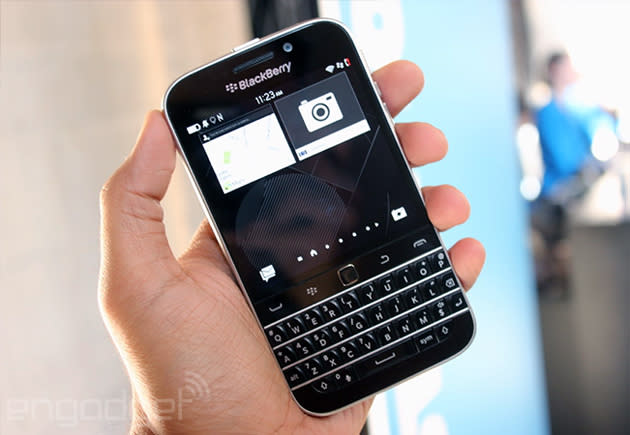
BlackBerry didn't bother throwing in the same top-tier parts here as it did in the square-shaped Passport. In fact, BlackBerry apparently wanted to complete the throwback formula by choosing a chip that's been around for ages: a 1.5GHz dual-core Snapdragon S4 Plus, paired with 2GB of RAM. That might sound like a nail in the Classic's coffin, but the reality isn't nearly that grim. The process of actually navigating the Classic -- thumbing down web pages, swiping between home screens and sifting through messages in your Hub -- is all pretty painless. Then again, BlackBerry has almost always nailed this sort of bread-and-butter functionality, so it's really no surprise that the Classic handles all that with aplomb.
(This is the point in the review where I'd normally drop in a pretty little table of benchmarks, but that would've been an exercise in futility -- a slew of Android benchmarking apps might have run on the thing, but there's no way they were going to tell us the full story.)
With all that said, there's still a lingering sense of slowness that can be hard to ignore sometimes. And those sideloaded Android apps? They can be rock-solid when they feel like it, but more often than not you'll tap one to launch and wait... and wait... before it finally springs to life. Oh, but wait: Your ordeal isn't over yet. There's also the question of how well the app will even run. Rdio, for instance, moved with all the urgency of a glacier, which would almost be tolerable if it could consistently play music worth a damn. Longish startup times aren't even exclusive to apps you've downloaded yourself, either. I stared at a black screen for seven or eight seconds waiting for something as mundane as the Reminders app to get its act together, and five-second lulls were common when firing up still other first-party apps. These constant, seemingly minor delays are an ever-present reminder that what I had in my hands wasn't even pretending to be a flagship. They're the price you pay to own a piece of nostalgia incarnate.

At least you won't be left wanting more juice. The non-removable 2,515mAh battery will easily get you through a full day plus a bit of downtime at home before needing a top-up. Thanks to a battery-saving mode baked into BB 10.3.1, I managed to get the phone to last until noon the next day, but even so, the brightness and performance trade-offs can be a bitter pill to swallow. Thankfully, you can determine when those power-saving measures kick in, and even if you want them to at all. Here's what really gets me, though: Sticking around for a full day of work is table stakes for a BlackBerry, and the Q10 hangs in there just about as long as the Classic does with a removable battery. While it would've been nice to see the company give us the option of swapping cells, the battery is really the least of the Classic's issues.
The competition

Let's face it: If you're even considering this thing, it's because you feel that deep, urgent sense of longing for everything BlackBerry stands for. If that's the case, you may want to consider the Passport instead: Its innards are in line with plenty of other top-tier smartphones on the market, and that curious touch-sensitive keyboard is all sorts of lovely once you get used to it. Throw in a bigger, more pixel-packed screen and you've got yourself a real BlackBerry flagship... even if it did make us all scratch our heads when we first saw it. Both the Classic and the Passport (or at least, a less pointy version of it) will be available on AT&T at some point, but there's still no firm word on when. For now, if you're a BlackBerry buff in the US and you need to replace your aging Bold, buying these things unlocked at full price is the only way to go.
On the off chance your BlackBerry allegiance is starting to waver, you could also cut out the software middleman and go straight for an Android device. Bear in mind, the Classic costs $449 unlocked -- assuming you could wait until Tuesday rolls around, a 64GB OnePlus One could be yours for a full $100 less. Yes, you lose the thrill of pecking on a physical QWERTY keyboard, but you'll get a better screen, a better camera and Android apps that run the way they're supposed to. If you're considering signing an agreement with AT&T to get the Classic, you could also nab a contract-free LG G3, a device we mostly loved that'll cost you about $30 more than an unlocked Classic. Neither of these choices will really sate your desire for a BlackBerry, but they will be worthy pocket companions. And hey, if you ever long for the company of your BlackBerry-toting friends, the BBM app is just a few taps away in the Google Play Store.
Wrap-up

Saying that the BlackBerry Classic isn't for everyone is like pointing out that snow is really quite chilly and oxygen is a lovely thing to breathe. It's so obvious that it barely means anything at all. What the Classic is, though, is a mostly reliable device, so long as you're willing to put up with its many, many quirks. I toted the thing through the thrumming hellscape that is the CES show floor, and I was grateful for its comfortable keyboard and its constant flow of easily glanceable messages. But did I feel so much as a pang of regret or longing when it came time to put the Classic back in its box?
Take a wild guess. Everything I needed to get my job done and beyond (even with stringent corporate IT policies in place) was available -- and ran better -- on my iPhone and Android devices. In the end, the Classic is a device with its heart in the right place, but a head stuck in the past. Unless you've been on this roller-coaster ride since the good old days, or you're a sucker for a good underdog story, leave this thing on the shelf. The rest of the world has moved on, and you probably have too.

